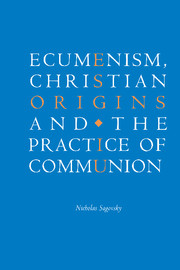Book contents
- Frontmatter
- Contents
- Acknowledgements
- List of abbreviations
- 1 The common life
- 2 Communion: Anglicans, Roman Catholics, and ecumenical consensus
- 3 Plato's vision
- 4 Aristotle's revisionism
- 5 Covenant and community
- 6 Little communities and the Catholic church
- 7 Cappadocian koinonia
- 8 Augustine and the story of communion
- 9 Ecumenism and the practice of communion
- Select biblography
- Index
9 - Ecumenism and the practice of communion
Published online by Cambridge University Press: 22 September 2009
- Frontmatter
- Contents
- Acknowledgements
- List of abbreviations
- 1 The common life
- 2 Communion: Anglicans, Roman Catholics, and ecumenical consensus
- 3 Plato's vision
- 4 Aristotle's revisionism
- 5 Covenant and community
- 6 Little communities and the Catholic church
- 7 Cappadocian koinonia
- 8 Augustine and the story of communion
- 9 Ecumenism and the practice of communion
- Select biblography
- Index
Summary
The starting point for this study was the recognition that the term koinonia has been used almost universally in current ecumenical discussion: in bilateral discussions like those of the Anglican–Roman Catholic International Commission and the Roman Catholic–Orthodox dialogue, and in multilateral discussions like those of the World Council of Churches' Baptism, Eucharist, and Ministry process, and the Fifth World Conference on Faith and Order, whose report was entitled On the Way to Fuller Koinonia. Within the Roman Catholic Church there has since Vatican 2 (1962–5) been a striking convergence around the self-understanding of the Church as communion. There has also been a new recognition of the communion that already exists, though in various ways impaired, between the Roman Catholic Church and other ecclesial bodies. This willingness to recognise the ecclesial life of churches not in communion with the Bishop of Rome has brought Roman Catholicism much more fully into the ecumenical movement.
If the churches have been discovering each other afresh in koinonia, this has by no means been simply a process of convergence. It has also been a process in which boundaries, such as those marked by the ordination of women to the priesthood and episcopacy, and episcopacy itself, are being drawn more sharply. In this sense, the facing of new issues and new social situations is causing churches to review, and in some cases to define more sharply, the limits to communion. There are real tensions here, which are far from being resolved.
- Type
- Chapter
- Information
- Ecumenism, Christian Origins and the Practice of Communion , pp. 194 - 208Publisher: Cambridge University PressPrint publication year: 2000



